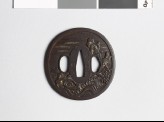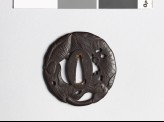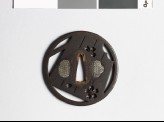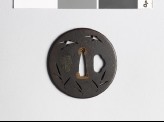The A. H. Church Collection of Japanese Sword-Guards (Tsuba)
An unpublished catalogue of the A. H. Church collection of Japanese sword-guards (tsuba) by Albert James Koop.
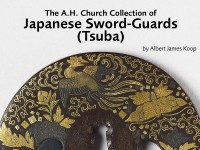
The masters of this school originally worked in Suruga [Japanese text] province, attaching themselves to the armourer family of Haruta [Japanese text]. The first Master, Haruta Takatsugu I., went successively to Mikawa (1597) and Harima (1600), dying in Bizen (1615); he did not make guards, however. The second, Iyetsugu, who had followed him to Bizen in 1615, changed the family name to Hayata [Japanese text], which it retained thenceforward; he made guards resembling the old armourers’ work (Group II), signed Bizen Suruga, and died in 1628. The third, Muneiye, went to Inaba province (Inshū, [Japanese text]) in 1632, and from this point onwards we meet with the signature Inshū no jū Suruga [see EAX.10447]. The fourth, Iyehisa, worked at the Inaba capital, Tottori and died in 1661. He was followed by Toshiiye (d. 1720), Takaiye (d. 1761; his guards are pierced and show Itō influence), Takaoki (or Takayasu?; di. 1856), and finally the tenth Master, Takayuki (d. 1895; worked at Tōkiō). Several other signatures have been noted, mostly of 19th century workers.
The guards of this school are in iron of excellent quality and the style shows Chōshū and Kinai influence. Cleanly modelled designs, often pierced and with an occasional heightening of gold, are characteristic of Suruga work. From about 1800 we find the tang-hole often supplied with ready-made copper plugs, neatly finished (see Introduction).
 Tsuba with goose amongst susuki grass (EAX.10447)
Tsuba with goose amongst susuki grass (EAX.10447)
 Tsuba with goose amongst susuki grass (EAX.10448)
Tsuba with goose amongst susuki grass (EAX.10448)
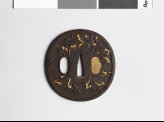 Tsuba with clematis trails (EAX.10449)
Tsuba with clematis trails (EAX.10449)
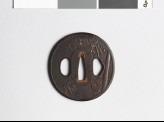 Tsuba with bamboo (EAX.10450)
Tsuba with bamboo (EAX.10450)
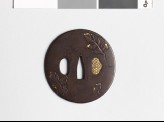 Tsuba with chrysanthemum leaves (EAX.10451)
Tsuba with chrysanthemum leaves (EAX.10451)
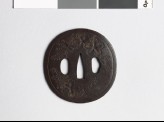 Tsuba with leaves and cherry blossoms (EAX.10452)
Tsuba with leaves and cherry blossoms (EAX.10452)
Notice
Object information may not accurately reflect the actual contents of the original publication, since our online objects contain current information held in our collections database. Click on 'buy this publication' to purchase printed versions of our online publications, where available, or contact the Jameel Study Centre to arrange access to books on our collections that are now out of print.
© 2013 University of Oxford - Ashmolean Museum

